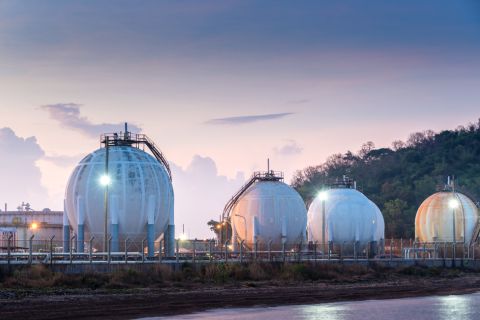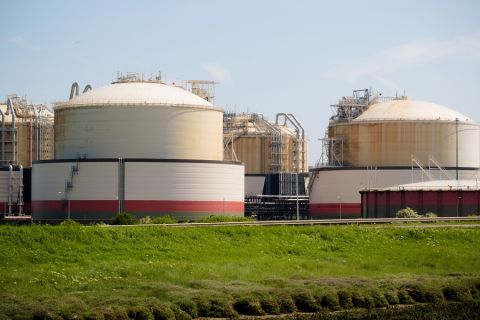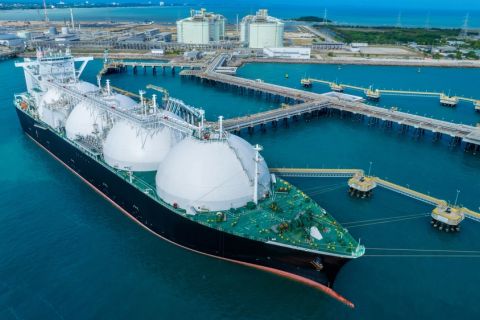Flaring produces about 400 MMtons of greenhouse gas emissions annually, according to the World Bank-led Global Gas Flaring Reduction (GGFR) partnership. While flaring is less damaging to the environment than directly venting natural gas into the atmosphere, it does produce CO2 and a host of other harmful pollutants. Until now, the only solution to the flaring problem has been to build expensive transmission pipelines to transport the natural gas to distant markets. But since the oil in a petroleum reserve is about 30 times more valuable than the associated natural gas, oil companies have chosen to flare much of the associated gas they produce rather than investing in the infrastructure to collect, process and market it.
This may be about to change, however, with the deployment of syngas-to-gasoline (STG+) technology, which transforms natural gas directly into liquid transportation fuels such as diesel and gasoline as well as organic solvents.
In addition to producing fuel, the STG+ process also can be used to produce a synthetic crude in situations where there is no demand for fuel or where the demand for fuel is not large enough for the amount of fuel product that can be produced. The ability to produce a synthetic crude that is compatible with the oil being produced at the wellhead also allows the operator to take advantage of existing petroleum infrastructure and logistics for transportation to market.
The STG+ technology also can be used in “stranded” gas situations in which a natural gas resource is stranded for physical or economic reasons—i.e., the resources are too remote or too small to justify the expense of developing dedicated pipeline infrastructure. Small-scale plants could unlock the economic potential of these stranded natural gas assets, allowing smaller producers to make transportation fuels for local markets.
The technology
The STG+ process involves two stages. The first is to create syngas (a mixture of carbon monoxide and hydrogen) from natural gas through a standard steam reforming process. After being scrubbed to remove unwanted sulfur and CO2, the syngas then enters the second stage, a liquid fuel synthesis train consisting of four catalytic reactors that transforms the syngas (in the case of gasoline) into methanol; dimethyl ether; heavy gasoline, which is gasoline containing compounds known as durenes whose high melting point can cause drivability problems due to carburetor icing; and durene-free light gasoline, which is what is used in a car’s gas tank. By adapting process settings or changing catalysts, the process also can produce diesel, aviation fuel or organic solvents. (The “plus” in STG+ stands for the multiple end products.)
While other gas-to-liquids (GTL) technologies can turn natural gas into fuels, the flexibility and efficiency of the STG+ technology makes it economical even at the small scales required in an oilfield situation. Fischer-Tropsch, which was invented in Germany in the 1920s and used by the petroleum-starved Nazis to make fuel from coal to power their war effort, is the most widely used GTL technology. But it is only profitable at enormous scale, in part because it requires two steps: The process creates a synthetic crude from natural gas or coal, but that synthetic crude must then be refined to create end products such as diesel and lubricants. For instance, the world’s largest GTL plant, Shell’s Pearl plant in Qatar, is said to have cost more than $19 billion.
The other competing technology is ExxonMobil’s methanol-to-gasoline (MTG) process, which was used for about 11 years at a plant in New Zealand in the 1980s and 1990s before being abandoned when a drop in oil prices made it uneconomic. The MTG technology can produce fuel without any extra intermediate steps but has other limitations, including the fact that it only produces one end product—gasoline—and that the gasoline it produces has a high content of durenes. While the STG+ process is based on MTG, it uses a four-reactor rather than a three-reactor process to improve the quality of the end product, with the innovation minimizing complexity through proprietary innovations concentrated around the composition and makeup of the catalytic reactors themselves.
Advantages
STG+ is cost-effective at smaller scales. This is made possible by its high efficiency. It has yielded very high efficiency rates at demonstration scale, converting each MMBtu of natural gas directly into more than 5 gal of high-quality gasoline blend stock drop-in gasoline. Researchers at Princeton University who compared the process with Fischer-Tropsch and MTG have found that STG+ is more efficient and cost-effective in general but especially at scales of 10,000 bbl/d or less, enabling a business model of smaller, geographically dispersed plants. This efficiency also contributes to a low-cost end product. The cost of fuels produced through STG+ is comparable to the cost of fuels produced from oil at about $65 per barrel. Since oil is currently trading at a higher price, the price would have to drop significantly for fuels produced from the process to be rendered uncompetitive.
Finally, the process holds an advantage over competing processes in that it can directly yield a range of end products, including diesel, gasoline and organic solvents, and that those end products can be used directly in the tank. The fuel produced is also of very high quality: The gasoline product, for instance, has a 90+ octane rating, contains less than 1 ppm of sulfur and zero benzene, and meets or exceeds other standards.
As a solution to the flaring problem, the technology holds another advantage. By eliminating the need to build a natural gas pipeline infrastructure, the use of the technology at the wellhead eliminates leaks from downstream natural gas transmission lines, which are a large source of “fugitive” methane emissions.
A growing problem
According to the GGFR, flaring increased from 138 Bcm (4.9 Tcf) in 2010 to 140 Bcm (5 Tcf) in 2011, the most recent year for which statistics are available. This increase can be expected to lead to more pressure to monetize assets that are now being wasted as well as more pressure to address the environmental consequences of flaring. STG+ technology holds the potential to be an effective, low-cost solution to the flaring problem, not only in the U.S. but in the many countries around the world where flaring has become an issue.
Recommended Reading
Gunvor Group Inks Purchase Agreement with Texas LNG Brownsville
2024-03-19 - The agreement with Texas LNG Brownsville calls for a 20-year free on-board sale and purchase agreement of 0.5 million tonnes per annum of LNG for a Gunvor Group subsidiary.
US Expected to Supply 30% of LNG Demand by 2030
2024-02-23 - Shell expects the U.S. to meet around 30% of total global LNG demand by 2030, although reliance on four key basins could create midstream constraints, the energy giant revealed in its “Shell LNG Outlook 2024.”
Venture Global, Grain LNG Ink Deal to Provide LNG to UK
2024-02-05 - Under the agreement, Venture Global will have the ability to access 3 million tonnes per annum of LNG storage and regasification capacity at the Isle of Grain LNG terminal.
Asia Spot LNG at 3-month Peak on Steady Demand, Supply Disruption
2024-04-12 - Heating demand in Europe and production disruption at the Freeport LNG terminal in the U.S. pushed up prices, said Samuel Good, head of LNG pricing at commodity pricing agency Argus.
CERAWeek: JERA CEO Touts Importance of US LNG Supply
2024-03-22 - JERA Co. Global CEO Yukio Kani said during CERAWeek by S&P Global that it was important to have a portfolio of diversified LNG supply sources, especially from the U.S.




